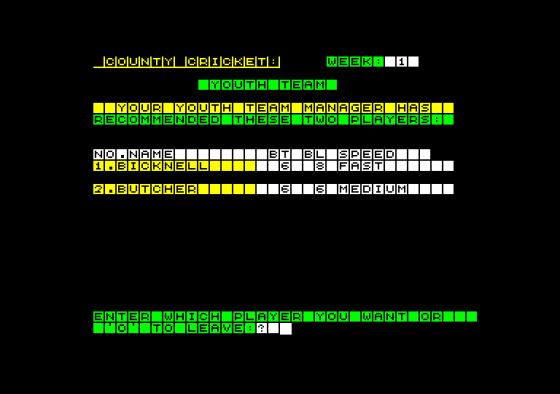
Amstrad Action
 1st November 1990
1st November 1990
Categories: Review: Software
Author: James Leach
Publisher: Cult Games
Machine: Amstrad CPC464
Published in Amstrad Action #62
County Cricket
Long summer days. Peaceful village greens. The sound of the church bells o'er the lea as they gently chime four o' clock. And the graceful smack of leather on willow, followed by a smattering of applause. These are the gentle images of cricket that many Englishmen hold so dear.
Of course, cricket these days is more often perceived as a high-pressure, drug-ridden whirlwind of hotel-related sexploits and dangerously fast bowling. Cricket has entered the '90s to the sound of breaking bones and heated arguments. There is big money in International Tests, and consequently there are big winners and losers. But perhaps County Cricket still provides a haven from this veritable three-ring-circus of international sporting nonsense. Yes, the counties must surely retain that cultured air of refined benevolence which gave rise to the British Empire. Possibly.
D & H Games, the self-styled "Masters Of Strategy" also produces Multi-Player Soccer Manager, reviewed in AA61. With County Cricket, it is remaining true to the text-only for-mat was seen in that game.

Once the program has loaded, you are presented with a choice of county sides. Simply select the one you wish to manage, input your name and away you go. There is a main menu, which will allow you to choose your team, train your men in whatever aspect of their game you feel warrants further practice, or view your fixtures over the season.
The team line-ups are quite faithful to real life, especially considering that players come and go with more rapidity each season. Each player has several ability ratings, as well as data concerning his specialised skills, be they batting, bowling, wicket-keeping and so on. You can then select the order you wish your batsmen to play, and you can make substitutions to the team if you like.
Training can also be set in one of four fields: batting, bowling, fielding and general ability. There is obviously a limited amount of training you can achieve in the short space of time before the season begins, though.

Your first fixture is set, your men are ready, and the crowd is waiting (if they've bothered to turn up). Time for the toss. You may choose heads or tails (detailed, this bit) and if you win, you get to choose whether to bat or bowl.
The computer has been using a rather nice scoreboard-style typeface to display all the data up until now, and once the game starts, you see... a scoreboard. This displays all the data needed to follow a match; who's batting and bowling, the score, when the wickets (if any) have fallen, and the overs bowled. At the beginning you can specify between 40 and 60 overs for the season's matches.
The game progresses. Very, very slowly. Further investigation reveals that much (if not all) of the coding is in BASIC. This would account for the pedestrian gameplay. Each ball bowled takes several seconds, so an innings takes well over an hour. If you are batting, the computer will change bowlers regularly. You then get the option to modify your batting approach to suit the new bowler. For example, if the he is fast, you might want to adopt a defensive posture. These decisions constitute the sum total of your interaction with the game as it's being played.

"Ah", you might exclaim, "isn't this rather realistic? Real cricket takes an eternity to play, too." This is true, but in real cricket there is at least something to watch during the boring bits, such as buses going up and down outside the ground or West Indians dancing because they're on the brink of victory (again). In County Cricket you are forced to sit and wait. After a while you start hoping that your batsmen are all bowled out just to hurry up the game.
Cricket fans might initially be impressed by the depth of detail in the program, despite the lack of graphics or sound. A lot of accurate information is included, and the atmosphere is set for an exciting County Championship competition.
It's a pity, then, that this excitement simply doesn't materialise.
All inputs have to be made using the keyboard, and it is occasionally necessary to hold down a key in order for the computer to register it. This really sums up the whole program. Sadly, in the long run, even hardened cricket fans will find it difficult to sustain any enthusiasm for County Cricket.
Mind you, at least you don't have to listen to Richie Benaud, though.
Second Opinion
Cricket's slow enough in the first place - you need a few (hundred) hours to spare if you want to get into a match. But as for a game that goes even slower than the real thing...
First Day Target Score
Finish a game.
Verdict
Graphics 20%
P. Text layouts look acceptable.
Sonics 0%
N. Not even the clunk of bat on ball.
Grab Factor 38%
N. Looks detailed and competent.
Staying Power 30%
N. But takes aeons to play.
Overall 30%
It's just not cricket...













